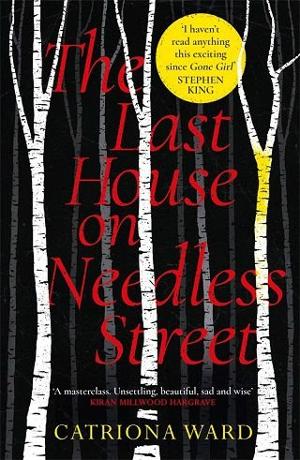Afterword
Afterword
If you haven’t finished The Last House on Needless Street yet, please don’t read on – what follows is one long spoiler.
This is how I came to write a book about survival, disguised as a book about horror. In the summer of 2018 I was writing about a cat and I couldn’t work out why. I had always been fascinated by the apparent ease with which those who lack empathy form strong, passionate attachments with their pets. Serial killer Dennis Nilsen’s dog, Bleep, was the only creature he could be said to have had any functional relationship with. He loved Bleep and the fate of the dog was the only thing he was concerned with after his arrest. So I thought, Maybe this is the right story, the one I should be working on. Olivia the cat, who lives with Ted and gives him comfort, even though he took a young girl named Lauren and keeps her captive. But it wasn’t working. Ted didn’t seem like a murderer, or a kidnapper. I kept finding pockets of compassion for him. His story felt like one of suffering and survival, not like that of a perpetrator. And Olivia didn’t really behave like a cat. She did have cat-like qualities but her voice seemed neither human nor feline, but something other. She seemed like a part of him. So did Lauren, the girl who was ostensibly Ted’s prisoner.
I was researching the effects of childhood abuse when I came across a video online of a young woman named Encina, who has dissociative identity disorder, discussing her condition. She talked with great frankness and compassion about her younger alter. She treats her as her child, adopting a maternal attitude, taking care of her, making sure she’s not scared, or faced with activities she can’t accomplish, like driving. The younger alter came forward, for a time, and spoke. She talked about how lonely she is, because no other children want to play with her, because the body she’s in is big and they don’t understand. I felt that my outlook on life changed as I watched them talk. The video is listed in the bibliography (What It’s Like To Live With Dissociative Identity Disorder (DID)). I realised that the book I was writing had never been about a cat named Olivia, a girl called Lauren and a man named Ted. It was about someone who had all these personalities within them. It wasn’t about horror but about survival and hope, and how the mind copes with fear and suffering.
I had heard of DID before. It’s the staple of many a horror plot. But watching Encina’s system describe how their personality had diverged in order to deal with abuse, I felt that a piece of the world I had never understood had fallen into place. The world felt stranger now, but also more real. It was a kind of miracle, but it also made perfect sense, that the mind should do this.
I rang a friend of mine who is a psychotherapist. She has worked with, among others, survivors of trafficking and torture. ‘Is this real?’ I asked. ‘I mean, is this a real thing?’ I wasn’t very articulate.
‘In my experience it’s absolutely real,’ she said.
For over a year I went down a long rabbit hole, reading everything I could get my hands on to do with DID. I suddenly understood what the book was, and where it needed to go.
There are people in the therapeutic community and the world at large who firmly believe the disorder doesn’t exist. DID seems to threaten people’s worldview. Maybe it’s because it interferes with the concept of the soul – the idea that there can be more than one person in a body is somehow terrifying. It certainly disrupts the underlying tenets of many religions.
The stories that accompany this disorder are without exception horrific. It’s the mind’s last resort, when faced with unbearable pain and fear. I am particularly grateful to First Person Plural, one of the major support groups for people with dissociative identity disorder in the UK, for helping me better understand this intricate condition. Their website and online resources are listed at the back of the book.
I spoke with someone who has dissociative identity disorder and works with others who have it, over the course of a long afternoon. They have asked not to be named. We met for the first time at a train station and went to a café nearby to talk. We were both flustered and shy at first. It’s an intimate thing to discuss between strangers. But they laid open their past, and their life, with unflinching honesty.
They talked about how DID isn’t a disorder when it first comes into being. It saves a child’s mind from unendurable strain; it performs a life-saving function. It’s only later in adult life, when it’s no longer necessary, that it becomes a disorder. They talked about one of their alters, ‘Legs’, who doesn’t talk. Legs’ only function had been to get them back to bed after the abuse. They described how, while the abuse was happening, they would send all the different parts of their body away. All they held onto was the big toe, which they used to draw the body back together again afterwards. They told me that some alters used to despise the parts who experienced the abuse. Some of them don’t understand why they’re in a body that doesn’t reflect who they are in age, gender or appearance. It makes them angry. Some of them have tried to hurt the body. Other alters try to maintain a distance, ‘vacuum-packed’, sealed off from the rest of the system. They want to live a separate, parallel life. The purposes of the different alters are clearly defined. The alter who goes to work will be cold towards family or a partner if they ring or come to see them during the day. The work alter does the job, just that.
They described how differently memory works for them. Each alter holds certain experiences. Memory is not linear, but nested in a series of compartments. ‘I will never know what it feels like to remember things like you,’ they told me. It can make seemingly simple tasks difficult. When following a recipe, for instance, they can’t remember more than four ingredients at a time. Retaining too much information is dangerous because it means they might have to remember other things too. Sometimes they leave a gap between switches, leaving the body vacant for a moment, so that alters don’t have to share knowledge. They described how difficult it is to pack for a holiday; remembering to put everyone’s different things into the suitcase, clothes for all the alters of different ages. They described their own inner worlds, where their alters convene: a farmhouse at the centre of a crossroads, where approaching enemies can be seen from any direction; a playground guarded by armies; a beach.
They told me that they were healing. The alter who used to rip up photographs, trying to destroy the past, has stopped. After years of therapy and with a family of their own, they are learning to live together as one.
Towards the end of our meeting I asked, ‘What would you like people to know about the disorder, that you don’t feel is understood?’
‘I’d like people to know that we are always striving towards the good,’ they said. ‘We are always protecting the child.’
It could take a lifetime to understand this complex disorder. There seem to be many variations between cases, and a multitude of different ways in which dissociative identity disorder can manifest. Ted is not based on a particular case. He is wholly imagined and any mistakes are all my own. But I have tried to do justice in this book to the people whose lives are touched by DID – to hold onto what was said to me that afternoon, over our cooling cups of coffee. Dissociative identity disorder may often be used as a horror device in fiction, but in my small experience it is quite the opposite. Those who survive, and live with it, are always striving towards the good.
 Fullepub
Fullepub 



